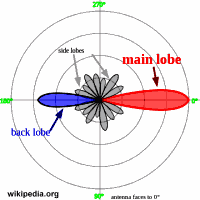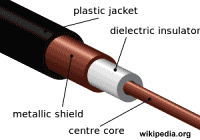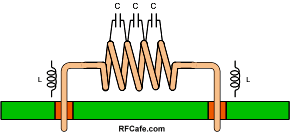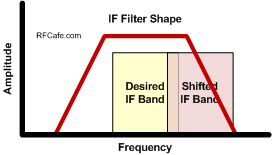 All RF Cafe Quizzes make great fodder for
employment interviews for technicians or engineers - particularly those who are
fresh out of school or are relatively new to the work world. Come to think of it,
they would make equally excellent study material for the same persons who are going
to be interviewed for a job. Bonne chance, Viel Glück, がんばろう,
buena suerte, удачи, in bocca al lupo, 행운을 빕니다,
ádh mór, בהצלחה, lykke til, 祝你好運.
Well, you know what I mean: Good luck! All RF Cafe Quizzes make great fodder for
employment interviews for technicians or engineers - particularly those who are
fresh out of school or are relatively new to the work world. Come to think of it,
they would make equally excellent study material for the same persons who are going
to be interviewed for a job. Bonne chance, Viel Glück, がんばろう,
buena suerte, удачи, in bocca al lupo, 행운을 빕니다,
ádh mór, בהצלחה, lykke til, 祝你好運.
Well, you know what I mean: Good luck!
Click here for the complete list of
RF Cafe Quizzes.
Note: Some material based on books have quoted passages.
This RF Electronics Basics quiz targets those of
you who are newcomers to the world of radio frequency (RF) electronics, but seasoned
vets are welcome to give it a go as well. Please report any suspected errors to me via
e-mail. Return to Quiz #69.
1. What comprises radio frequency signals?
 b)
Electromagnetic
waves. b)
Electromagnetic
waves.
An electromagnetic wave consists of time-varying electric and magnetic waves in phase
with and at right angles with respect to each other.
2. How does an antenna achieve gain when it has no active signal
amplification?
 b) Gain is achieved by directing (concentrating)
a majority of the signal in a preferred direction rather than equally in all direction. b) Gain is achieved by directing (concentrating)
a majority of the signal in a preferred direction rather than equally in all direction.
As the radiation
pattern plot to the right shows, the power contained in the main lob, compared to
all other directions, is greater. That represents a directional gain as compared to if
the power was spread out equally in all directions.
3. Why do RF people often speak of power in units of dBm and dBW
rather than milliwatts and watts, respectively?
d) Using dBm or dBW (decibels relative to a milliwatt or watt, respectively)
allows multiplication and division of gains and losses to be performed as addition and
subtraction, respectively.
Using dBm or dBW (decibels
relative to a milliwatt or watt, respectively) allows multiplication and division of
gains and losses to be performed as addition and subtraction, respectively.
The multiplication of A and B, A * B, is the equivalent of the addition
of the logarithm
(log) of A and the log of B, log (A) + log (B).
A * B = log (A) + log (B).
The division of A by B, A / B, is the equivalent of the subtraction of the
log of B from the log of A, log (A) - log (B).
A / B = log (A) - log (B).
Therefore, dBm and dBW, both being logarithms of power ratios (relative to a milliwatt
or watt, respectively), allows gains and losses expressed in decibels (dB) to be added
and subtracted directly to power levels expressed in decibels (dBm, dBW).
Example: An amplification factor of 13 (13x) of a 250 mW signal yields 13 * 250 mW
= 3,250 mW. Equivalently, log (13) + log (250) = 1.11394 + 2.3979
= 3.51188. Antilog (3.51188) = 103.51188 = 3,250.
Keep in mind that although units of dBm and dBW are numerical ratios as is the dB,
dBm and dBW represent actual power levels in milliwatts and watts. There is a tendency
for people to confuse and conflate dB with dBm and dBW.
4. Why do coaxial (coax) cables specify a minimum bend radius?
 a)
Too tight of a bend alters the internal physical dimension to where the impedance change
profoundly affects the internal signal. a)
Too tight of a bend alters the internal physical dimension to where the impedance change
profoundly affects the internal signal.
The coaxial
cable's characteristic impedance is a function of the radii of the outer metal shield
and the central conductor, and of the dielectric material that fills the space between
them. Ideally, the inner and outer conductors are perfectly round and perfectly concentric
(i.e., coaxial). Changing the geometry changes the impedance. A too-sharp bend alters
the geometry by smashing dielectric and shifting the center conductor off-center and
thereby changes the impedance. Any change in impedance sets up reflected waves inside
the cable, which causes variations in the signal amplitude along the length of the cable.
5. Why do discrete components - resistors, capacitors, and inductors
- eventually not work as frequencies increase beyond some point?
c) Parasitic resistance and reactance progressively dominates the component
impedance as the frequency increases.
 Capacitance exists between parallel conductor surfaces
such as between adjacent windings on an inductor or transformer as well as between metal
in other nearby components (including a circuit board ground plane and signal traces),
etc. Inductance is present in all lengths of metal such as external leads, internal bond
wires (in IC's), surface mount pads, etc. Those "parasitic" reactances can be ignored
at low frequencies, but as the frequency increases, their effects grow more significant.
At a component's self-resonant frequency (SRF), the magnitudes of capacitive and inductive
reactance are equal, and above the SRF the components exhibits the opposite form of reactance;
i.e., capacitors act like inductors and vice versa. Capacitance exists between parallel conductor surfaces
such as between adjacent windings on an inductor or transformer as well as between metal
in other nearby components (including a circuit board ground plane and signal traces),
etc. Inductance is present in all lengths of metal such as external leads, internal bond
wires (in IC's), surface mount pads, etc. Those "parasitic" reactances can be ignored
at low frequencies, but as the frequency increases, their effects grow more significant.
At a component's self-resonant frequency (SRF), the magnitudes of capacitive and inductive
reactance are equal, and above the SRF the components exhibits the opposite form of reactance;
i.e., capacitors act like inductors and vice versa.
6. What can cause a poorly shielded AM or FM radio to change its
audio level as you vary your distance from it?
a) Your body creates half of a capacitor (the radio and/or antenna is the other
half) that can alter the resonant frequency of the radio's local oscillator(s).
 As a result, the intermediate frequencies (IF) shift
toward the edges of the IF filters rather than in the center, thereby attenuating the
signal more intensely. As a result, the intermediate frequencies (IF) shift
toward the edges of the IF filters rather than in the center, thereby attenuating the
signal more intensely.
7. What does the "S" in S-Parameters stand for?
d) Scattering. The term "scattering" in physics
refers to deviation in the intended path of travel due to interruptions. In the case
of electrical signals, impedance discontinuities cause reflections. An s-parameter matrix
is used to mathematically describe the relative changes in signal strength and phase.
Each port (potential entrance or exit of the signal) has a unique set s-parameters that
describes it relationship with every other port. For example, in a 3-port device like
a circulator, S31 describes the signal exiting Port 1 when it is injected into Port 3.
S33 describes the signal exiting Port 3 when it is injected into Port 3; i.e.,
the portion of the injected signal that is reflected back out the port.
8. What is the phase shift at the shorted end of a coaxial cable?
c) 180° A good illustration is a rope attached
fast to a pole so it cannot move. Give the far end of the rope a whip and watch the wave
travel down the rope toward the pole. When it reaches the pole, the wave is reflected
back toward you in the opposite phase (180° shift). This is so because in order for the
amplitude of the wave to equal zero (0) at the pole (since that end cannot move), some
force must exactly cancel out the amplitude and phase of the wave. The only thing that
can do that is a force equal in amplitude and at the opposite phase, hence the 180° phase
shift (as with a short circuit). The same phenomenon occurs with an electrical wave.
Conversely, if the rope is attached to the pole such that the end
can freely move up and down the pole, the wave on the rope will cause the end of the
rope to move to the position on the pole where the wave would be if the pole was not
there. The wave reflects backward beginning at the same amplitude and phase as is arrives.
Hence there is 0° of phase shift (as with an open circuit).
9. At what rate does the power of an RF signal attenuate in free
space?
c) 6 dB for every doubling of distance. An
electric field's voltage falls off at a rate of 1/r, where "r" is the distance from the
source. At twice the distance, 2r, the field intensity is 1/2r. In terms of decibels,
the relative voltage level is 10 * log (1/2) = 10 * (-0.301)
= -3.01 dB. Since power is proportional to the square of the voltage, the
relative power power level is 10 * log (1/22) = 10 * log
(1/4) = 10 * (-0.602) = -6.02 dB. Note: The negative sign indicates
a reduction in gain, hence, attenuation.
10. What is the name of the frequency band occupied by license-free
devices such as WiFi routers and Bluetooth headphones?
a) ISM
(Industrial, Scientific, and Medical) Many frequency bands
are designated by the FCC and other countries' regulatory bodies for unlicensed use.
They were originally created for use in the industrial, scientific, and medical communities,
but have evolved to include many other domestic and commercial uses.
Posted February 7, 2018
|































 Capacitance exists between parallel conductor surfaces
such as between adjacent windings on an inductor or transformer as well as between metal
in other nearby components (including a circuit board ground plane and signal traces),
etc. Inductance is present in all lengths of metal such as external leads, internal bond
wires (in IC's), surface mount pads, etc. Those "parasitic" reactances can be ignored
at low frequencies, but as the frequency increases, their effects grow more significant.
At a component's self-resonant frequency (SRF), the magnitudes of capacitive and inductive
reactance are equal, and above the SRF the components exhibits the opposite form of reactance;
i.e., capacitors act like inductors and vice versa.
Capacitance exists between parallel conductor surfaces
such as between adjacent windings on an inductor or transformer as well as between metal
in other nearby components (including a circuit board ground plane and signal traces),
etc. Inductance is present in all lengths of metal such as external leads, internal bond
wires (in IC's), surface mount pads, etc. Those "parasitic" reactances can be ignored
at low frequencies, but as the frequency increases, their effects grow more significant.
At a component's self-resonant frequency (SRF), the magnitudes of capacitive and inductive
reactance are equal, and above the SRF the components exhibits the opposite form of reactance;
i.e., capacitors act like inductors and vice versa. As a result, the intermediate frequencies (IF) shift
toward the edges of the IF filters rather than in the center, thereby attenuating the
signal more intensely.
As a result, the intermediate frequencies (IF) shift
toward the edges of the IF filters rather than in the center, thereby attenuating the
signal more intensely.